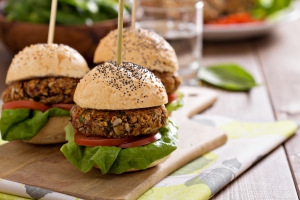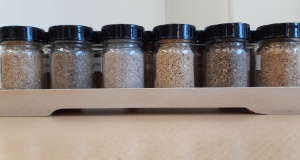Plant-based meat products served out-of-home grow by almost 50% across Europe’s ‘Big 5’ countries
- Sizzling 90% growth for plant-based burgers, while sales of sandwiches fall
- Annual consumer spend finally exceeds pre-COVID 19 levels, but visits to OOH hospitality venues remain lower at -10%
- 25% of Europe’s Big 5 population follow a flexitarian diet – a trend that is set to grow in 2024
BRACKNELL, UK – 8 November 2023 – According to research from Circana, the leading advisor on consumer complexity that formerly traded as IRI and The NPD Group, the trend towards eating alternative plant-based meat protein products in out- of-home (OOH) eateries, such as quick-service restaurants (QSR), cafes, pubs and bars has increased by 48% in servings compared to 2019 across Europe’s ‘Big 5’ countries. While in other food protein categories, the number of total product servings declined, including Beef (-5%), Pork (-16%), Chicken (-5%), Fish/Seafood (-13%) and Other Meat (-20%).
Typically made from ingredients such as soy, peas, lentils and mushrooms, plant-based products have gained popularity in recent years as fast-food chains and restaurants throughout Europe cater to growing consumer demands for sustainable, healthier and cruelty-free menu options. When asked about factors influencing their choice of where to eat out, 45% of consumers overall said they are more loyal to restaurants that care about sustainability, with Italy voicing the strongest concern (56%) followed by Spain (49%) and the UK least concerned (38%).
Burgers buck the trend
Compared with other protein categories, plant-based meat has shown the strongest growth across all formats since 2019. The overall number of servings across each protein category has dropped with one exception – burgers. While the number of servings in other formats, such as sandwiches and wraps, have declined, the burger has shown solid growth (Beef +4%, Chicken +16%, Fish +11%, Other Meat +14%).
Despite the overall decline in visits to OOH venues, plant-based burgers grew significantly by +90% during year ending August 2023 vs 2019, and +20% year-on-year ending Aug 2023, representing a quarter (25%) of the total contribution made to growth in burgers.
Please read the full article here.
Source photo: Kent Wild Life Trust
Plant-based mushroom innovation sees the light
Growing mushrooms above ground and sprouting soybeans are two entrepreneurial efforts looking to make plant-based protein ingredients more nutritious, affordable and sustainable.
Mush Foods, Ltd., Rehovot, Israel, a portfolio company of the Strauss Group Kitchen FoodTech Hub founded in 2021, now offers a 50CUT mycelium protein ingredient system to reduce the animal protein content in meat products by 50%, said Shalom Daniel, co-founder and chief executive officer of Mush Foods. The ingredient requires no agricultural land and uses minimal energy and water, according to the company. Cultivation does not depend on season or climate.
A binder and whole protein, the mushroom mycelium needs no added binders and offers an umami flavor and a fleshy meat-like texture as well as fiber, vitamins and minerals, Mr. Daniel said.
The company so far has developed 50CUT beef and 50CUT chicken. Pilot plants will be built in the United States. Company plans are to launch sales in the first quarter of 2024.
Read the full article here.
Source: Food Business News
Meet the Garden Giant
Today in the leading role the 'King Stropharia', commonly known as the wine cap mushroom. This mushroom gets its name from the rich wine-red color and knows its origin in North America. The King Stropharia reaches 20 cm high and has a reddish brown rounded to flattened cap that can become 30 cm wide, therefor the name 'Garden Giant' or 'Godzilla Mushroom'. The gills have initially a pale color, then become gray and finally dark purple-brown. The firm flesh is white, as is the high stem that bears a wrinkled ring. King Stropharias have a delicious rich mushroomy flavor with undertones of potatoes and red wine and the stem has an asparagus-like texture. These delicious mushrooms are extremely low in sodium and calories, as well as fat and cholesterol free. They also contain iron, protein and calcium, making them a healthy addition to your meal.
Read all about this wonderful mushroom here.
Supplement, the unknown ingredient?
If a consultant is visiting a farm there are always many things to discuss in detail.
Shall we give more or less water and are we able to water over the mushrooms?
Do we need a slower or faster fructification?
Is the amount of pins sufficient or do we need more and how do we then get a decent stagger?
Even discussions about compost although many growers do not really know the details. But they know about structure, moisture and smell. Because this is what they discuss at filling.
The same about casing soil. Is it heavy this time or just fine? Wet or dry?
But talking about supplement one finds out that most of the growers have absolutely no idea how it works, what it really is and the choices they can make. Generally the price is the main buying point.
And this is strange to me. Because compost and casing are always changing during the year. This is mainly due to the seasonal effect on the raw materials. Straw is maturing in the storage, chicken manure will change in nitrogen level and peat is changing moisture depending on the season of the year. Manufacturing companies will react to that but smaller changes are inevitable.
To keep production at the same level or to enhance it, the supplement however can be changed to your liking. Most of the growers only know that there is a slow or normal release product. But it is possible to customise the supplement to the situation of that moment. Not just slow or fast but even pinpointed to a certain phase of the growing. To give an example: one of the farms I work on now wanted more activity in second flushes and a longer shelflife. In cooperation with the compost supplier and the supplement supplier they have now “composed” a supplement that can do that. Be aware though that it also needs adapting of the growing. You are putting more proteins into the compost so the activity changes too. This means that also the watering and the picking have to change.
But this way many combinations are possible.
There are different raw materials to mix and several processes to make the release time fitting your schedule.
A few remarks though have to be made.
It only works well in cooperation with the compost supplier. The ingredients of the supplement have to be an addition to the nutrients in the compost. So it has to fit the analyses of the compost.
The best way to use it if it can be mixed in at the compost yard. And this is only profitable with bigger quantities of compost. Mixing it in at filling is not as efficient as on the compost yard.
Do not just look at protein levels. Because some proteins are not available to the mushrooms and will still be in the compost at the moment of emptying the room.
So look at effective protein. This often is a matter of price. Good proteins come with a price.
And remember: good supplement makes good compost better. But good supplement makes bad compost worse.
























